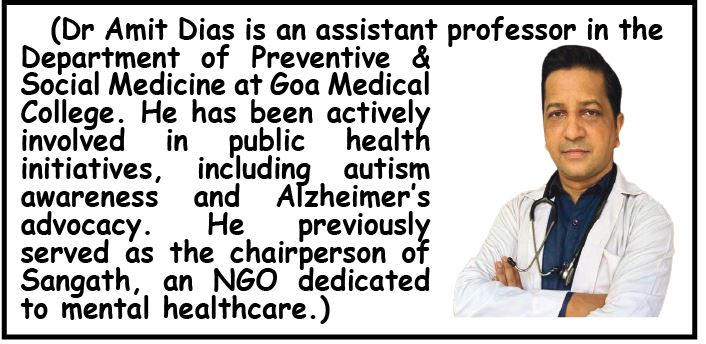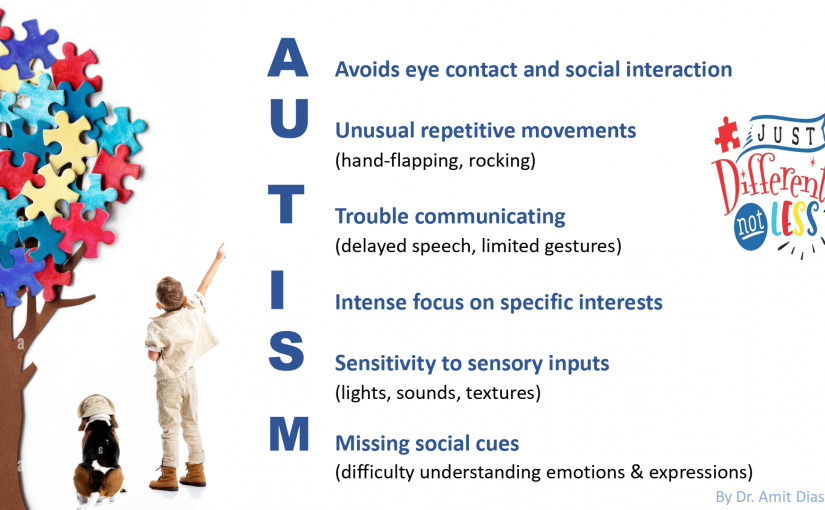An insightful Q&A interview with Dr Amit Dias
April 2 is World Autism Awareness Day. To shed light on the Autism Spectrum, we spoke to Dr Amit Dias from the Department of Preventive & Social Medicine at Goa Medical College. He says “Children with autism are different, but not less. We need to change our approach and support children with autism.” Here he explains how to make your home autism-friendly and embrace neuro-diversity.
Goan Observer: Dr Dias, thank you for joining us, we hear so much about autism these days, could you explain what it means?
Dr Amit Dias: Autism, is not a disease, it’s a condition where the brain is working differently. Being autistic does not prevent you from enjoying life, it does not mean you will not have friends, it just means you may need more support to do these things. We need to change our approach — If they can’t learn the way we teach, we need to teach the way they learn.
Autism is a lifelong, neurological condition that typically manifests before the age of three. It significantly affects verbal and non-verbal communication, social interaction, and behavior. Children with autism may exhibit stereotyped or repetitive movements, fixated interests, and either heightened or diminished responses to sensory stimuli. There could be a range of presentation and the degree of severity of each of the symptoms could vary from person to person. We need to change our mindset — Why try to fit in when you are born to stand out? They are different, but not less.
Q : Can you simplify and help us recognize autism?
A: Remember “AUTISM” to know Autism: Here are some of the early symptoms you need to watch for.
Avoids eye contact and social interaction
Unusual repetitive movements (hand-flapping, rocking)
Trouble with communication (delayed speech, limited gestures)
Intense focus on specific interests
Sensitivity to sensory inputs (lights, sounds, textures)
Missing social cues (difficulty understanding emotions and expressions)
Q: That would be very useful for all the parents. What is the focus for Autism Awareness day this year?
A: The theme for 2025 is “Advancing Neurodiversity and the UN Sustainable Development Goals (SDGs).” The theme highlights the connection between neurodiversity and global sustainability efforts. It underscores how inclusive policies and practices can lead to meaningful change for individuals with autism. Additionally, it stresses the importance of recognizing early signs of autism and seeking professional guidance, as well as appreciating diverse ways of experiencing the world.
Q: How big is the public health problem of Autism Spectrum Disorders?
A: Autism is quite common. The World Health Organization (WHO) estimates that approximately 1 in 100 children worldwide have autism. However, many cases go undiagnosed, particularly in lower socioeconomic groups where access to appropriate and affordable care is limited. Autism does not only affect the individual; it impacts the entire family in some way or the other, including caregivers and extended family members who must adapt to the child’s needs.
Q: What is the Autism Spectrum?
A: The term “spectrum” reflects the wide variation in challenges and strengths possessed by each person with autism. Some individuals may have mild symptoms and function well in daily life, while others may experience profound disabilities and require significant support. Additionally, children with autism often have co-occurring conditions such as epilepsy, anxiety, depression, and attention deficit hyperactivity disorder (ADHD). They may also face behavioral challenges such as difficulty sleeping or self-injury.
Q: What causes Autism?
A: The exact cause of autism remains unknown, but research suggests it is multifactorial, involving both genetic and environmental factors. Certain genetic conditions, such as congenital rubella syndrome etc, are associated with autism. Brain development abnormalities have been observed in children with autism, but no single cause has been identified.
Q: Do vaccines cause autism?
A: No, vaccines do not cause autism. A study that originally suggested a link was found to have serious methodological flaws. The WHO has stated unequivocally that no scientific evidence supports a connection between vaccines and autism.
Q: How can parents recognize the early signs of Autism?
A: Every child is unique, but developmental delays in social, communication, and behavioral skills can indicate autism. Parents should consult a doctor if they notice any of the following signs and delay in the milestones.
By 6 months: Lack of smiling or joyful expressions
By 9 months: Absence of facial expressions (happy, sad, angry, surprised)
By 12 months: No babbling
By 14 months: Lack of gestures (pointing, waving goodbye)
By 16 months: No spoken words
By 18 months: Fails to show objects of interest
By 24 months: Does not use two-word phrases
By 36 months: Does not engage in play with other children
At any age: Loss of language or social skills, difficulty maintaining eye contact
Q: Can we prevent Autism?
A: There are no definitive measures to prevent autism spectrum disorder. However, optimal antenatal care, including maternal vaccinations like the rubella vaccine, can help reduce certain risk factors. Early diagnosis and intervention significantly improve outcomes. Though autism cannot be “cured,” children can develop skills to function better with appropriate support.
Q: What should family caregivers do if they have a child with autism?
A: Caring for a child with autism requires patience, understanding, and specialized strategies. Here are key steps:
Early Intervention – Seek professional guidance as soon as autism is suspected. Therapies such as speech therapy, occupational therapy, and behavioral therapy can significantly improve outcomes.
Education & Awareness – Learn about autism to better understand your child’s needs.
Create a Structured Environment – Children with autism thrive in structured, predictable settings.
Use Visual Communication Aids – Many autistic children respond well to picture schedules and other visual tools.
Encourage Social Interaction – Provide opportunities for social engagement at their comfort level.
Seek Support – Join support groups, connect with other caregivers, and consider professional counseling if needed.
Take Care of Yourself – Caregiving can be challenging. Self-care is essential to maintaining emotional well-being.
Q: How can we make a home autism-friendly?
A: This is an interesting question. You would have to tailor it to the condition and level of difficulty in the individual. Creating an autism-friendly home involves making the environment comfortable, predictable and accommodating to sensory and emotional needs. Here are some key strategies:
- Sensory-Friendly Spaces
Use soft lighting (natural light or warm LED bulbs) to avoid harsh glare.
Minimize background noise (fans, white noise machines, or noise-canceling headphones can help).
Offer varied textures in furniture, blankets and sensory-friendly rugs.
Provide a safe, quiet retreat (a designated corner with calming items like weighted blankets). - Predictable & Structured Environment
Use visual schedules (charts, pictures, or apps) to establish routines.
Label drawers and storage bins with clear symbols or words to improve organization.
Maintain a consistent daily routine to reduce anxiety. - Safety Considerations
Secure sharp objects, electrical outlets, and potentially harmful substances.
Use childproof locks if needed, especially for younger autistic individuals.
Install soft padding on sharp furniture edges if stimming or movement is frequent. - Personalized Comfort Zones
Allow choices in furniture arrangements to suit personal space preferences.
Offer fidget tools, stress balls, or sensory swings for self-regulation.
Consider a calm-down area with dim lighting, soft seating, and soothing sounds - Encouraging Communication & Independence
Use visual communication tools like PECS (Picture Exchange Communication System) if verbal communication is challenging.
Encourage independence with easy-to-reach storage for everyday items.
Provide alternative communication devices if needed, such as tablets with assistive apps. - Diet & Mealtime Adaptations
Use preferred utensils and plates to accommodate sensory sensitivities.
Maintain a consistent meal schedule with familiar foods while gradually introducing new ones.
Reduce overwhelming food smells by ensuring good ventilation. - Emotional Regulation & Coping Tools
Introduce mindfulness or breathing techniques for stress relief.
‘Provide break options when overstimulation occurs.
By creating a home that respects sensory needs, provides structure, and fosters independence, you can make a significant positive impact
Q: What is your message on World Autism Awareness Day?
A: We need to break barriers and celebrate diversity. Inclusion is not just about creating opportunities — it’s about preparing society to be inclusive. Every individual, including those with autism, has the right to a fulfilling life. Given the right environment and support, people with autism can make meaningful contributions to society.
The United Nations’ theme, “Advancing Neurodiversity and the UN Sustainable Development Goals (SDGs)” highlights the need to dismantle stigma and discrimination. People with autism are often deprived of healthcare, education and community participation. This must change, and we all have a role to play in fostering an inclusive world.

